The guitarist, Henry Whitter, slid his chair across the floor to bring his instrument a little closer to the recording machine’s sound-gathering horn. A harmonica dangled from his neck on a wire truss; he made a tentative puff on it and looked over to the man behind the controls.
Next to Whitter sat Kelly Harrell, a singer who’d traveled down with him from the same part of Virginia. Harrell tugged absently at his shirt collar. He cleared his throat.
“You boys ready?” the engineer asked. The men nodded. They shouldn’t have been so nervous—they’d done live recordings before, after all—but then, you never got used to it. Making things worse was the fact that the room was so damn hot. They’d been in here for just a few minutes, but already their shirts were soaked through with sweat.
And now it was time. The engineer counted to three and tilted a finger their way. On the bed of the machine before them, a wax platter began spinning. As it turned, a metal blade sliced into it and trimmed a delicate rind from its surface. Whitter led the song off, puffing the melody out on his harmonica once around before Harrell squared his body to the horn and began to sing:
I was borned about ten thousand years ago
There was nothing ever happened I don’t know
I saw Pharaoh and his daughter shooting craps for a quarter
And I heard him say, ‘Oh girl I’ve won your dough.’
The voice was an odd quantity. Phrases spilled from Harrell’s mouth in a long and lagging way. He inserted dips and swoops in his verses, beating words that didn’t have an obvious relationship with each other into something like a rhyme. It was strange voice, but it sold records.
The next morning, the Asheville Citizen had the story: “There is a lot of respiration and perspiration connected with the making of phonograph records. This was demonstrated in the recording laboratory of George Vanderbilt Hotel yesterday when the Okeh Record Company began making a series of ‘hill country records.’”
“Today, a number of singers and players from the mountain country will be tried out before the reproducing device,” the Citizen newspaper story continued. “The first test is said to be one of the severest experiences the singer or player ever has to undergo and more difficult than an appearance before a large audience.”
It was the last week of August 1925, and the music industry had come to Asheville. Its temporary home and workshop was a turret-like structure atop the Vanderbilt’s roof, where, earlier in the week, the Okeh men assembled their make-do “laboratory.” The walls were hung with blankets in order to mask the faint clack of the trolleys, the bleat of horns and human voices rising from Haywood Street below, and the periodic rumbles and moans of the Vanderbilt’s elevator. The “reproducing device” was put together and leveled, and chairs set out for the musicians.
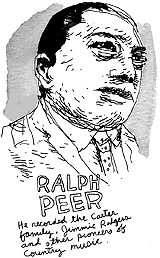
In charge of all of this was Ralph S. Peer, artists-and-recording director for New York City-based General Phonograph Company and its label, Okeh Records. It was an increasingly familiar routine for Peer: arrive at a Southern city, set up, audition whichever musicians responded to the company’s advertisements, winnow the talent from the chaff, make some wax “test” records and return to New York. Already that year, Peer had led nine of these “field recording” excursions, including two dates in Atlanta, one in St. Louis and another in Kansas City.
Okeh’s Asheville stay, the Citizen report explained, was “the first time phonograph records have ever been made in the Carolinas.” Yet, already the company had found the atmosphere of Asheville “to be the best in the country for the reproduction of the human voice and instrument music.” It was expected, the story went on to relate, “that the company will make the majority of its Southern records in this city.”
Three years before, the record business was under assault by a new technology—radio—and Peer struck on an idea. The industry’s standard fare—operatic sopranos, marching bands and jazz orchestras—were losing their appeal. But Peer believed there was a market for records that had yet to be exploited. The secret, he figured, lay in ethnic music: Hungarian violinists, Russian singers, German polka bands, Swedish choirs. And though at first he was reluctant, in time Peer turned his attention to the American South, with its simmering stew of blues, gospel, string bands, hoary balladeers and cornpone humorists.
And rather than try to get those artists to the company’s headquarters in New York, as was the custom, Peer determined that it was in Okeh’s best interest to bring the recording studio to them. The formula was working, and by 1922, the South had given Okeh two popular new categories: “race records,” performances by African-American blues and gospel singers, and “hill country records” of artists who tended to be rural and white.
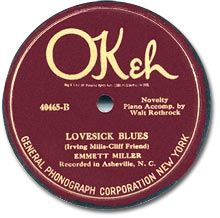
This wasn’t the first time the industry had flirted with rural music. In 1914 and again in 1916, Columbia Records recorded a fiddler from Clinton, N.C., named Don Richardson, including his version of an old-time standard with a unique spelling: “Arkansaw Traveler.” The virtuosic Texan fiddler Alexander “Eck” Robertson was recorded in New York by the Victor Talking Machine Company in 1922, but for the most part, Robertson’s sides and those of earlier fiddlers were little more than novelties, barely hinting at the rich seam of black, Cajun and Anglo melodies found below the Mason-Dixon Line.
During a field-recording date in Atlanta in 1923, Peer minted what would be the industry’s first “hill country” star. Okeh had come to the Georgia city to record blues and gospel performers, but toward the end of the company’s residency there, Peer was introduced to Fiddlin’ John Carson, a white musician from the north-Georgia hills. Peer recorded Carson—grudgingly, country music lore has it—in conditions that were less than ideal. The sound of Carson’s record, Peer would later say, was “pluperfect awful.”
Nevertheless, a test pressing of 500 of Carson’s debut—“Little Old Log Cabin in the Lane” on the A-side and “The Old Hen Cackled and the Rooster’s Going to Crow” on the reverse—sold out in the span of an afternoon.
At first, Okeh took to calling the music of Carson and others who fit the same profile “hill country” or “old-time.” It would be a few years before the success of a band from Galax, Va., would lend the genre another name: “hillbilly,” a title that stuck until the 1940s, when it was replaced by “country.”
More than Atlanta even, Asheville held the promise of “hill country” talent. For one, Peer had a reliable informant in Bascom Lamar Lunsford, a Leicester song-catcher who practiced law. As a young man, Lunsford traveled throughout Western North Carolina, selling fruit trees and gathering scraps of melody and verse. He called at remote mountain cabins and lingered in the company of musicians and singers, acquiring, by one estimate, at least 3,000 songs and other folkloric materials in the course of his life. Already in 1924, Lunsford had been recorded by Okeh in Atlanta, waxing two songs: “I Wish I Was a Mole in the Ground,” which he learned from a fellow student at Rutherford College, and “Jesse James,” which Lunsford got from Sam Sumner of Bat Cave. This, Peer must have realized, was a good person to have around.
“Asheville in the 1920s was an interesting place,” observes Bob Carlin, a Grammy-nominated banjoist and author of String Bands in the North Carolina Piedmont (McFarland & Company, 2004). “It was a very sophisticated place in many ways, but it was also right in the middle of the mountains. There was industry there and opportunity, but very soon after you got out of the city limits, you were in the heart of the mountains and there was a lot of music to be had.”
Artists from Western North Carolina had been recorded in the past, but well outside of their own setting. “Previously, if you wanted to record, you had to travel to New York,” Carlin notes, citing the examples of Samantha Bumgarner, Eva Davis and Ernest Thompson, who in 1924 recorded in New York for Columbia.
“That was a pioneering session for this music,” Carlin says. Bumgarner, who was from Jackson County, was the first five-string banjo player ever to be recorded, and the first woman to record music that could be considered “country.”
“But it was a new thing to make recordings in the South,” Carlin notes. “And the Asheville sessions were an early venture of the companies out of New York and into the Southern mountains.”
Peer wasn’t guided by any notions of historic preservation. He wasn’t a folklorist, and had no particular interest in the rustic arts. He’d come to Asheville in hopes of nosing out talent that would make his company money. With him to the mountains, Peer brought Okeh’s recording engineer, Charles Hibbard, and the company’s general-sales representative, G.S. Jeffers. Up from Atlanta for the event was Polk C. Brockman, Okeh’s regional-distribution chief.
The Okeh men wore fine suits and had a refined air about them, not unusual for guests at the Vanderbilt. What set them apart were the things they brought with them: piles of heavy, folded blankets, trunks filled with mechanical apparatuses, tins clinking with fine metal styluses, crates packed with hundreds of carefully wrapped wax discs, legal forms and ledgers.
Whitter and Harrell, the Virginians, were the first to survive the Okeh test in Asheville, and they went on to record perhaps a dozen more sides that hot August afternoon before yielding their seats to a pair of banjoists from Winston-Salem named R.B. Smith and S.J. Allgood. The latter recorded but one side, a rendition of “American and Spanish Fandango” that ran three minutes and sounded as gentle as waves tickling a lakeshore. It was, the Citizen related, “unusually fine.”
The hotel Okeh picked as its home base hadn’t been there a year before. Like much of Asheville, the seven-story Vanderbilt was brand-new, part of a wave of freshly built upscale lodgings in the city. And while it lacked the scale and outward refinement of the nearby Battery Park Hotel, the Vanderbilt was posh throughout, from its tiled reception room to its Grand Ballroom. Above it all was the Vanderbilt’s roof garden, with its whitewashed wood pergola and dance floor beneath, open to the evening stars.
Days prior to the start of recording, the would-be stars of hill-country music crowded the Vanderbilt’s lobby, hoping for the opportunity to sit before the horn. And what a sight they must have been: milling about the reception area and the sidewalk outside, the roughest among them in slouch hats and denim chore coats, with battered instrument cases clasped in their knobby hands.
Recording began at the Vanderbilt on Tuesday, Aug. 25. A fresh-faced singer of 35, Kelly Harrell was a renowned entertainer and sometimes mill-worker from Drapers Valley, Va. A year before Okeh’s Asheville date, Harrell went to New York to record for the Victor Talking Machine Company, but Peer had since made him a better offer.

His accompanist in Asheville, Henry Whitter, despite a reputation for possessing only a faltering musical ability, was shaping up to be Okeh’s go-to backer for its old-timey selections. Described in the company’s catalog as “the most novel entertainer for he plays a harmonica and a guitar at the same time and never misses a note,” Whitter was labeled by the trade publication The Talking Machine World as nothing short of “a mountain star.”
A day later, Ernest V. Stoneman, and autoharp player and ballad singer from Galax, Va., waxed 10 or more sides in the Vanderbilt’s rooftop hot-box, including “The Sailor’s Song,” “Blue Ridge Mountain Blues,” a spry number called “The Fancy Ball” and “John Hardy,” which told the story of “a desperate little man” who “carried two guns every day.”
By Thursday, with his brother Blackwell chirping along on fiddle, Leicester’s singing attorney, Bascom Lamar Lunsford, had recorded two sides at the Vanderbilt, including “Fate of Santa Barbara,” a song commemorating the California city’s earthquake of just two months before.
“Fate” sat neatly within a hot sales category known as “event songs”—songs of trapped spelunkers, wind-whipped fire, shipwrecks and God’s obvious hand in them—which had become central to Okeh’s catalog. On this count Lunsford gave the company what it wanted. Also during that week, Lunsford wrote an even more current event song called “The Last Battle,” or “Bryan’s Last Battle,” which told the story of the Scopes “Monkey Trial” which had wrapped up just a month before, after which the prosecutor, the famous populist William Jennings Bryan, promptly died. Later, Lunsford recorded the song under the title “Evolution.”
Following Lunsford into the studio was Fisher Hendley, a banjo player and singer from North Carolina’s Piedmont. He recorded two sides. After Hendley’s turn at the horn came a duo named J.D. McFarlane and Daughter that recorded two tunes: “Devil in the Woodpile” and “Whistlin’ Rufus.” McFarlane Sr. played the fiddle, and his unidentified daughter played a pretty good piano accompaniment.
On Tuesday of the next week, the duo named the Carson Brothers was joined in the Okeh laboratory by autoharp player Roosevelt Smith. Their entire output from that day whispered from beyond the grave, including such toe-tappers as “Oh! We Miss You,” and “Don’t Grieve Over Me.”
Even by the standards of the time, the Asheville sessions were unusually well-stocked with banjo players. “One of the interesting things about these sessions is the variety of banjo styles,” observes Wayne Martin, director of the North Carolina Arts Council’s Folklife Program. The Asheville sides hint at a world of styles on that instrument before a certain banjo player from Shelby, N.C., laid waste to them.
“When Earl Scruggs came on the scene in the 1940s, his style was so pervasive that everyone who played a banjo ended up playing three-finger banjo,” Martin says. “But back in this time, there was an incredible variety in the way the banjo was played.”
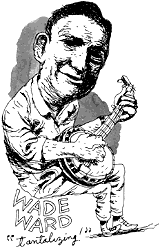
Turning up in Asheville from Independence, Va., was the 33-year-old banjoist Wade Ward, who played his instrument in the “clawhammer” style. Ward’s four sides were never issued by Okeh, but at least one of the test records he recorded that day—“Married Man’s Blues”—survives. In his book Country Music Records: A Discography, 1921-1942 (Oxford University Press, 2004), the English music historian Tony Russell referred to this glimpse of a young Ward, who in his autumn years was studied and emulated by a generation of old-time revivalists, as “tantalizing.”
From West Asheville came Ernest Helton, a half-Cherokee musician with lustrous black hair and lean, film-star good looks. Helton’s talents on several instruments were in demand throughout the region, and in an Asheville City directory from the time, Helton was listed under that rarest of occupations, the professional musician.
While Helton was a gifted player of old-time music, for the Okeh sessions he chose to break out a formal parlor piece on the banjo called “Royal Clog,” a series of ascending and descending scales bridged by peculiar chromatic flights.
Later that day, Okeh captured one of just six recorded sides by J.D. Harris, a senior fiddler and sometimes band-mate of Helton’s who lived near Asheville at the time. Born in 1868 in Flag Pond, Tenn., Harris’ command of the bow and his tight phrasing—not to mention his legendary repertoire—would inspire a number of fiddlers from the region, including Cherokee’s Manco Sneed, Bill Hensley of the Avery’s Creek section of Buncombe County and Marcus Martin of Swannanoa.
Harris’ advanced age at the time of his recordings has led more than one music historian, including the late Charles Wolfe, to suggest that his playing embodied the sound of fiddling from at least as far back as the time of the Civil War, and perhaps earlier.
Harris recorded but one tune in Asheville, a solo fiddle piece called “The Cackling Hen.”
“Listening to Dedrick Harris makes me think of a passage in Cecil Sharpe’s diary from 1916,” says Adam Tanner, an old-time and blues fiddler who lives in Weaverville. “Sharpe talks about traveling for three weeks on horseback from Asheville to Hot Springs just to listen to a few select men and women sing.” Harris’s “Cackling Hen,” Tanner added, “is similar to the songs Sharpe went out of his way to hear, in that [it is] repetitive and odd, otherworldly and beautifully unpredictable.” By the time he sat for his sole Asheville recording, Tanner suggests, Harris “may have been one of the last of a generation to play a dying music.”
What wasn’t recorded in Asheville is arguably more tantalizing than what was. Stories are still in circulation that the ‘Singing Brakeman’ Jimmie Rodgers showed up but failed to impress the Okeh men. If Peer had any knowledge of Rodgers’ presence in Asheville in 1925, he never spoke of it, but the story persists nonetheless. Within a year’s time Rodgers was indeed living in Asheville, playing house parties around the city with Ernest Helton. But exactly when he arrived remains in question.
Other musicians are said to have missed out on the Asheville date as well. “I’ve been working on an article about the people who influenced Earl Scruggs, and one of the musicians who was a big influence on him was Smith Hammett,” Carlin says. “Hammett never recorded. But supposedly he was on his way to Asheville for these sessions and his car broke down. For whatever reason, he didn’t make it. So, that might have been a way that we could have heard Smith, and been able to make a more direct connection between Earl and him.”
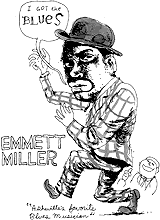
Both the Asheville Citizen and the Asheville Times attached considerable moment to the studio appearance on Sept. 1 of Emmett Miller. A blackface and vaudeville performer from Macon, Ga., Miller was in Asheville that week with Nan Fitzgerald, “Juvenile Comedienne in Songs and Dances,” playing to near-capacity crowds at the Majestic Theatre, located on the corner of College and Market streets downtown. In a Majestic advertisement in the Times that week, Miller was hailed as both “Asheville’s Favorite Blues Singer” and “Okeh Record Star.”
His output while in Asheville was modest but influential. With the piano accompaniment of Walter Rothrock, Miller recorded a self-written number, “You’re Just the Girl For Me,” “I Never Had the Blues (Until I Left Old Dixie Land),” “Big Bad Bill (Is Sweet William Now)” and, most interesting to country-music historians, what would be just the second recorded version of the landmark Irving Mills number “Lovesick Blues.”
Despite Miller’s obscurity today, his Asheville sides demonstrate that his “blue yodeling” presaged Jimmie Rodgers’ by at least a few years and Hank Williams’ by nearly a quarter-century. In 1949, Williams would have a number-one hit with “Lovesick Blues,” even as Miller’s own career was evaporating.
Last to record was the Vanderbilt’s house band, the Foor-Robinson Carolina Club Orchestra. The previous week, the Citizen reported that the orchestra was “putting the finishing touches on preparations for recording some of the numbers that have been so popular with dancers in the Vanderbilt ballroom.”
With temperatures in the high 80s, Wednesday, Sept. 2, was the hottest of Okeh’s 10-day stay in Asheville, and the band suffered considerably in the Vanderbilt’s “laboratory,” according to English jazz historian Mark Berresford. Nonetheless, the orchestra recorded two numbers, “Rose of the Nile,” with an exotic, snake-charmer melody, and “Collegiate,” a zippy tune with a rah-rah college chant at its center.
And then it was over. Even as the orchestra members filed out of the makeshift studio and toward the bar for a drink, the blankets were being folded, the chairs stowed and the ‘reproducing machine’ sent down the Vanderbilt’s elevator. Peer had what he wanted, 60 test records to take back with him to New York.
Okeh never returned to Asheville, even though Peer had told a Citizen reporter on his way out of town that he was “greatly pleased with the results obtained here and with the co-operation by local people.”
“The Okeh company,” continued the Citizen report with more than a little hopefulness, “expects to make Asheville headquarters for summer recording on account of the superior quality of the air here, which is cool and dry and ideal for their purposes.”
The air notwithstanding, the sound on the Asheville records was not good. In 1925, Okeh still employed acoustic microphones, which relied on direct sound pressure to activate the reproducing device’s needle. That same year, the electric microphone was introduced, becoming more or less universal within a year’s time.
Two summers later, under the banner of the Victor Talking Machine Company, Peer’s work would carry him to Bristol, Tenn., a city that today claims itself the “Birthplace of Country Music.” At sessions there, along with a list of musicians including Okeh’s Asheville alumni Ernest Stoneman and Henry Whitter, Peer would capture the first sounds of Jimmie Rodgers and a trio from Maces Spring, Va., that called itself the Carter Family. The success of those two acts would soon reduce musicians such as Kelly Harrell, the strange-voiced singer from Drapers Valley, Va., to little more than footnotes in country-music history.
Harrell’s career would not outlast the Depression. Whatever his skills as a singer and a songwriter, the fact that he couldn’t play an instrument made him a dim prospect in the eyes of A&R men for whom the bottom line was everything.
But in Asheville during the last week of August 1925, all was promise.
At the turn of that year, Okeh announced the new recordings in its holiday catalog, including Harrell and Whitter’s version of the murder ballad “Wild Bill Jones,” with “I Was Born About Ten Thousand Years Ago” on its reverse. Above the description of their record is a snapshot of the two men, taken on the Vanderbilt’s roof. Harrell’s shirt hangs loosely about his small frame, the top button sprung open. He looks tired from his time spent in the “laboratory,” arms slack at his side. Next to him, the larger Whitter stands more proudly, his Gibson guitar angled across the front of his body. Both men are squinting into the late-summer sun.
“The rich-voiced Kelly Harrell has made a record to be proud of,” reads the description beneath the photo. “First because it consists of two very fine songs, and second, because he is such an accomplished singer.”
“Be sure to get this record,” the catalog says, “and learn what you missed.”


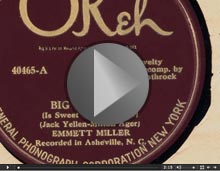
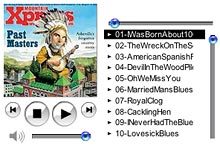
Kent,
Thanks so much for such a rich and detailed account of Asheville’s country music history.
My experience is that most folks around here tend to focus on bluegrass and mountain music, which is fine, but as a country singer-songwriter-bass player, it’s so rewarding to learn about country music’s Asheville roots.
When trying to book our Asheville-based country vocal group, Deep River, in local venues, I’ve been told by managers, “You’re not bluegrass enough”, “Though I tend to like your type of music, it doesn’t work here” and “We generally book rock/party cover bands.”
Fortunately, there are some wonderful venues that are booking us like Feed & Seed in Fletcher, The Back Room in Flat Rock, The Purple Onion in Saluda and Asheville’s Grove Park Inn.
Hopefully, we can help grow the local country music scene here for many people to enjoy once again.
With gratitude,
Sharon Lewis
Band Leader, Deep River
http://www.myspace.com/deepriver